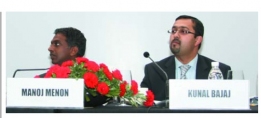Telecom Outlook: Impact of 3G - Future perspectives

-
3G auctions in India are being characterised by high reserve prices and a limited number of slots of spectrum across circles, with a maximum of only three spectrum slots being auctioned per circle.
For incumbent GSM operators, it is imperative to win the 3G spectrum auctions. In the short term, deploying 3G services will enable the players to retain their high average revenue per user (ARPU) customers by offering them better quality of services. This is extremely vital since the government is looking to roll out mobile number portability. In the long term, these operators can expand revenues by extending their data-intensive 3G services to the top 200-300 cities.
For dual-technology players such as Tata Teleservices and Reliance Communications, acquiring 3G spectrum is of great significance. These companies will utilise the 3G spectrum and continue to leverage their evolution-data-optimised (EVDO) capabilities on the existing CDMA spectrum and infrastructure for data-centric wireless broadband.
Meanwhile, the GSM/CDMA nonincumbents are expected to bid opportunistically for specific circles. The new entrants will mostly concentrate on rolling out 2G services in the initial phase; however, a few of them, especially carriers with substantial foreign support, may carry out opportunistic bidding for 3G spectrum in some circles.This is likely to be more prevalent among carriers with substantial foreign support.
With the launch of 3G, handset bundling is expected to be increasingly adopted for better service-device integration. Incumbent GSM operators are likely to offer reverse bundling, where handsets are bundled with connections and voice minutes, and carrier bundling, where handsets bought by the operator are sold as a cobranded offer along with a connection, to all consumer segments including corporates and professionals, high-end youth and incremental low-ARPU subscribers. Dualtechnology players will offer all three types of bundled models – the above two and a subsidised carrier bundling model, which comprises handsets sold along with the connection where some subsidy is offered on the handset prices.
In fact, the flat-rate pricing adopted by telecom is unique across industries. Many industries have used pricing innovations as a primary driver to segment customers and tailor offerings by wallet size, but this proverbial genie out of the bottle has prevented telecom operators from maximising their investments.
The future business model for telcos is expected to be different. It is essential to maximise the number of services and applications on one's network catering to the entire subscriber base. Operators must focus on getting the best experience for the customers and make huge investments in order to reach the market with new innovations. They must also reduce service-related risks as well as focus on increasing minutes at the lowest cost per bit. The focus will be on a customised set of services for fewer segments. Operators will need to invest in platforms for the future. And, they must concentrate on unaddressed customer problems and needs, and retune the business model to capture value.
- Most Viewed
- Most Rated
- Most Shared
- Related Articles
- Manufacturing Hub: India emerges as a ke...
- TRAI performance indicator report for Se...
- Prashant Singhal, partner, telecom indus...
- 2G spectrum scam: continuing controversy
- An Eventful Year: Telecom highlights of ...
- Telecom Round Table: TRAI’s spectrum p...
- Manufacturing Hub: TRAI recommends indig...
- Linking Up: ITIL to merge with Ascend
- High Speed VAS - Killer applications w...
- Bharti Airtel seals deal with Zain - Zai...






